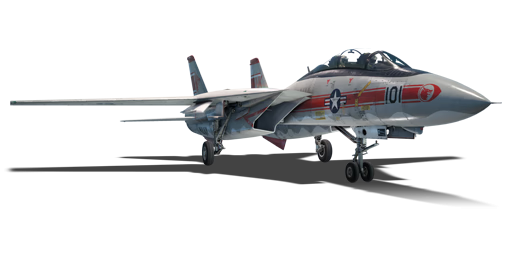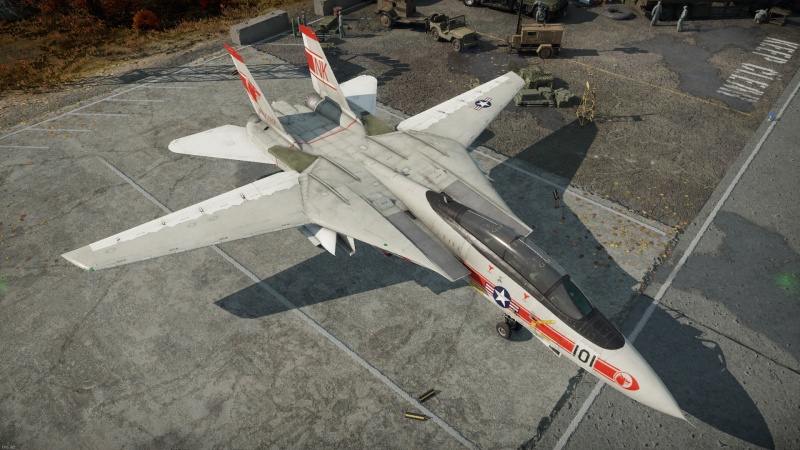Difference between revisions of "F-14A Early"
(i added a little bit extra info to the history section.) (Tag: Visual edit) |
Colok76286 (talk | contribs) (Undo revision 131253 by U56311838 (talk) Plagiarism from Wikipedia: Jalil Zandi) |
||
| Line 155: | Line 155: | ||
<!-- ''Describe the history of the creation and combat usage of the aircraft in more detail than in the introduction. If the historical reference turns out to be too long, take it to a separate article, taking a link to the article about the vehicle and adding a block "/History" (example: <nowiki>https://wiki.warthunder.com/(Vehicle-name)/History</nowiki>) and add a link to it here using the <code>main</code> template. Be sure to reference text and sources by using <code><nowiki><ref></ref></nowiki></code>, as well as adding them at the end of the article with <code><nowiki><references /></nowiki></code>. This section may also include the vehicle's dev blog entry (if applicable) and the in-game encyclopedia description (under <code><nowiki>=== In-game description ===</nowiki></code>, also if applicable).'' --> | <!-- ''Describe the history of the creation and combat usage of the aircraft in more detail than in the introduction. If the historical reference turns out to be too long, take it to a separate article, taking a link to the article about the vehicle and adding a block "/History" (example: <nowiki>https://wiki.warthunder.com/(Vehicle-name)/History</nowiki>) and add a link to it here using the <code>main</code> template. Be sure to reference text and sources by using <code><nowiki><ref></ref></nowiki></code>, as well as adding them at the end of the article with <code><nowiki><references /></nowiki></code>. This section may also include the vehicle's dev blog entry (if applicable) and the in-game encyclopedia description (under <code><nowiki>=== In-game description ===</nowiki></code>, also if applicable).'' --> | ||
===[[wt:en/news/7705-development-f-14a-tomcat-into-the-danger-zone-en|Devblog]]=== | ===[[wt:en/news/7705-development-f-14a-tomcat-into-the-danger-zone-en|Devblog]]=== | ||
| − | In 1968, five aircraft building companies entered the Pentagon's competition for a new carrier-based interceptor fighter. The commission's preference was given to Grumman's design, a twin-engine jet fighter with a variable-swept wing. Work on the F-14A fighter began in February 1969, and in December of the next year, the new aircraft took her maiden flight. The main weapon of the F-14A was the AIM-54 Phoenix long-range missiles controlled by the newest to date weapon control system. Instead of building prototypes, Grumman immediately switched to the production of an experimental series, and already on December 31, 1972, the first batch of jet fighters were put into service with the VF-124 Fleet Replacement Squadron . Pilot training took place on the deck of the USS Enterprise aircraft carrier, and during the withdrawal of US troops from Vietnam, combat sorties were also made from the deck. In total 557 F-14A fighters were delivered to the US Navy until 1987, and another 80 aircraft were built for Iran. Tomcats were used in all military conflicts where US aircraft took part until the very decommissioning. Iranian F-14s took an active part in the Iran-Iraq war, scoring dozens of air kills | + | In 1968, five aircraft building companies entered the Pentagon's competition for a new carrier-based interceptor fighter. The commission's preference was given to Grumman's design, a twin-engine jet fighter with a variable-swept wing. Work on the F-14A fighter began in February 1969, and in December of the next year, the new aircraft took her maiden flight. The main weapon of the F-14A was the AIM-54 Phoenix long-range missiles controlled by the newest to date weapon control system. Instead of building prototypes, Grumman immediately switched to the production of an experimental series, and already on December 31, 1972, the first batch of jet fighters were put into service with the VF-124 Fleet Replacement Squadron . Pilot training took place on the deck of the USS Enterprise aircraft carrier, and during the withdrawal of US troops from Vietnam, combat sorties were also made from the deck. In total 557 F-14A fighters were delivered to the US Navy until 1987, and another 80 aircraft were built for Iran. Tomcats were used in all military conflicts where US aircraft took part until the very decommissioning. Iranian F-14s took an active part in the Iran-Iraq war, scoring dozens of air kills. |
== Media == | == Media == | ||
Revision as of 04:40, 17 June 2022
Contents
Description
The F-14A Tomcat (Early) is a rank VIII American jet fighter with a battle rating of 12.3 (AB/RB/SB). It was introduced in Update "Danger Zone".
General info
Flight performance
Describe how the aircraft behaves in the air. Speed, manoeuvrability, acceleration and allowable loads - these are the most important characteristics of the vehicle.
| Characteristics | Max Speed (km/h at _,___ m) |
Max altitude (metres) |
Turn time (seconds) |
Rate of climb (metres/second) |
Take-off run (metres) | |||
|---|---|---|---|---|---|---|---|---|
| AB | RB | AB | RB | AB | RB | |||
| Stock | ___ | ___ | 16764 | __._ | __._ | __._ | __._ | ___ |
| Upgraded | ___ | ___ | __._ | __._ | __._ | __._ | ||
Details
| Features | |||||
|---|---|---|---|---|---|
| Combat flaps | Take-off flaps | Landing flaps | Air brakes | Arrestor gear | Drogue chute |
| _ | _ | _ | _ | _ | _ |
| Limits | ||||||
|---|---|---|---|---|---|---|
| Wings (km/h) | Gear (km/h) | Flaps (km/h) | Max Static G | |||
| Combat | Take-off | Landing | + | - | ||
| 0 | 518 | ___ | ___ | ___ | ~__ | ~__ |
| Optimal velocities (km/h) | |||
|---|---|---|---|
| Ailerons | Rudder | Elevators | Radiator |
| < ___ | < ___ | < ___ | N/A |
Engine performance
| Engine | Aircraft mass | |||||
|---|---|---|---|---|---|---|
| Engine name | Number | Basic mass | Wing loading (full fuel) | |||
| _____ | _ | _,___ kg | ___ kg/m2 | |||
| Engine characteristics | Mass with fuel (no weapons load) | Max Takeoff Weight | ||||
| Weight (each) | Type | _m fuel | __m fuel | __m fuel | ||
| ___ kg | ___ | _,___ kg | _,___ kg | _,___ kg | _,___ kg | |
| Maximum engine thrust @ 0 m (RB/SB) | Thrust to weight ratio @ 0 m (___%/WEP) | |||||
| Condition | 100% | ___%/WEP | _m fuel | __m fuel | __m fuel | MTOW |
| Stationary | ___ kgf | ___ kgf | _.__ | _.__ | _.__ | _.__ |
| Optimal | ___ kgf (_ km/h) |
___ kgf (_ km/h) |
_.__ | _.__ | _.__ | _.__ |
Survivability and armour
Examine the survivability of the aircraft. Note how vulnerable the structure is and how secure the pilot is, whether the fuel tanks are armoured, etc. Describe the armour, if there is any, and also mention the vulnerability of other critical aircraft systems.
Modifications and economy
Armaments
Offensive armament
The F-14A Early is armed with:
- A choice between two presets:
- 1 x 20 mm M61A1 cannon, cheek-mounted (676 rpg)
- 1 x 20 mm M61A1 cannon + 60 x countermeasures
Suspended armament
Describe the aircraft's suspended armament: additional cannons under the wings, bombs, rockets and torpedoes. This section is especially important for bombers and attackers. If there is no suspended weaponry remove this subsection.
Usage in battles
Describe the tactics of playing in the aircraft, the features of using aircraft in a team and advice on tactics. Refrain from creating a "guide" - do not impose a single point of view, but instead, give the reader food for thought. Examine the most dangerous enemies and give recommendations on fighting them. If necessary, note the specifics of the game in different modes (AB, RB, SB).
Pros and cons
Summarise and briefly evaluate the vehicle in terms of its characteristics and combat effectiveness. Mark its pros and cons in the bulleted list. Try not to use more than 6 points for each of the characteristics. Avoid using categorical definitions such as "bad", "good" and the like - use substitutions with softer forms such as "inadequate" and "effective".
Pros:
- Good turn rate despite being very large
- Very good radar with options including PD and TWS available
- 60 countermeasures provides ability to ward off missiles
- Lethal M61 Vulcan
- Arrestor Gear allowing for landings on aircraft carriers
- Very good missile options (9H sidewinders are upgrades of the G's and Phoenix's are very good radar missiles)
Cons:
- Very large aircraft
- To best use either speed or turn-rate players will need to sweep or unsweep wings
- Phoenix missiles create huge smoke clouds making it easy for enemies to see and dodge
History
Devblog
In 1968, five aircraft building companies entered the Pentagon's competition for a new carrier-based interceptor fighter. The commission's preference was given to Grumman's design, a twin-engine jet fighter with a variable-swept wing. Work on the F-14A fighter began in February 1969, and in December of the next year, the new aircraft took her maiden flight. The main weapon of the F-14A was the AIM-54 Phoenix long-range missiles controlled by the newest to date weapon control system. Instead of building prototypes, Grumman immediately switched to the production of an experimental series, and already on December 31, 1972, the first batch of jet fighters were put into service with the VF-124 Fleet Replacement Squadron . Pilot training took place on the deck of the USS Enterprise aircraft carrier, and during the withdrawal of US troops from Vietnam, combat sorties were also made from the deck. In total 557 F-14A fighters were delivered to the US Navy until 1987, and another 80 aircraft were built for Iran. Tomcats were used in all military conflicts where US aircraft took part until the very decommissioning. Iranian F-14s took an active part in the Iran-Iraq war, scoring dozens of air kills.
Media
Excellent additions to the article would be video guides, screenshots from the game, and photos.
See also
Links to the articles on the War Thunder Wiki that you think will be useful for the reader, for example:
- reference to the series of the aircraft;
- links to approximate analogues of other nations and research trees.
External links
Paste links to sources and external resources, such as:
- topic on the official game forum;
- other literature.
| USA jet aircraft | |
|---|---|
| Fighters | |
| F-4 | F-4C Phantom II · F-4E Phantom II · F-4J Phantom II · F-4S Phantom II |
| F-5 | F-5A · F-5C · F-5E · F-20A |
| F-8 | F8U-2 · F-8E |
| F-80 | F-80A-5 · F-80C-10 |
| F-84 | F-84B-26 · F-84F · F-84G-21-RE |
| F-86 | F-86A-5 · F-86F-25 · F-86F-2 · F-86F-35 |
| F-89 | F-89B · F-89D |
| F-100 | F-100D |
| F-104 | F-104A · F-104C |
| F-14 | F-14A Early · F-14B |
| F-15 | F-15A · F-15C MSIP II |
| F-16 | F-16A · F-16A ADF · F-16C |
| F9F | F9F-2 · F9F-5 · F9F-8 |
| Other | P-59A · F2H-2 · F3D-1 · F3H-2 · F4D-1 · F11F-1 |
| Strike Aircraft | |
| FJ-4 | FJ-4B · FJ-4B VMF-232 |
| A-4 | A-4B · A-4E Early |
| A-6 | A-6E TRAM |
| A-7 | A-7D · A-7E · A-7K |
| AV-8 | AV-8A · AV-8C · AV-8B Plus · AV-8B (NA) |
| A-10 | A-10A · A-10A Late · A-10C |
| B-57 | B-57A · B-57B |
| F-105 | F-105D |
| F-111 | F-111A · F-111F |





